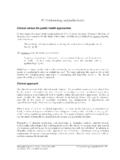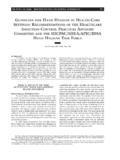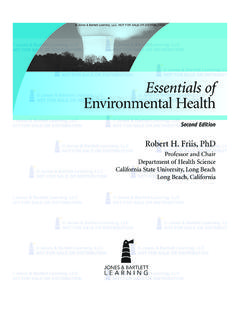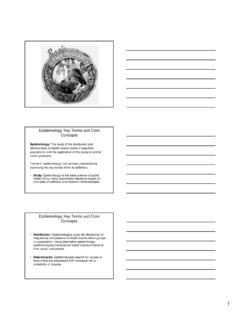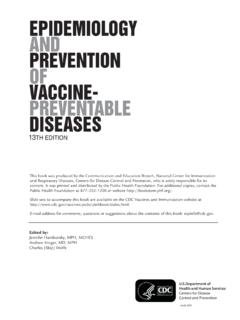Transcription of EXCITE | Epidemiology in the Classroom | Intro Epi
1 EXCITE | Epidemiology in the Classroom | Intro [1/6/2011 2:20:46 PM]On this PageFirst IncidentSecond IncidentThird IncidentEpidemiology DefinedEpidemiological StudiesDisease TransmissionField EpidemiologyEXCITE Home | Contact UsAbout ExciteEpidemiology inthe ClassroomCareers in PublicHealthScienceAmbassadorScience OlympiadResource LibraryEpidemiology in the ClassroomAn Introduction to EpidemiologyThis document is also available in Portable Document Format (891Kb). You will need Acrobat Reader to view and print background piece provides several working definitionsof Epidemiology the basic science of public health; anintroduction to the different categories of epidemiologyand types of epidemiological studies; and an overview ofthe disease transmission cycle.
2 First, to set the stage,consider the three incidents that follow, stepping into theshoes of the public health officer who received the initialreport and asking yourself the question, "What do I donow?" Some of these examples made national news andmay be familiar to IncidentIn March 1985, a nurse epidemiologist in a county health department noted,while reviewing surveillance data, three cases in a single month of hepatitis B ofunusual origin. Hepatitis B, or serum hepatitis, is transmitted through sexualcontact and by exposure to infected bodily fluids, but these three patients did notseem to have the usual risk factors. All three people did, however, indicatehaving received injections at the same health care nurse's immediate questions were: Is this a coincidence?
3 Did these threecases occur by chance or is there a link? In this instance, the nurse decided topursue an to TopSecond Incident At 8:30 in the morning on August 2, 1976, Dr. Robert B. Craven of CDC's ViralDiseases Division received a call from a nurse at a Veterans' Hospital inPhiladelphia, Pennsylvania. The nurse reported two cases of severe respiratoryillness, one of which had been fatal. Both people had attended the annualAmerican Legion Convention held July 21-24 . By the evening of August 2, 71more of the people attending the convention had the same illness, withsymptoms of acute onset of fever, chills, headache, malaise, dry cough, andmyalgia. Further conversations with local and state public health officials revealedthat between July 26 and August 2, 18 conventioneers had died.
4 Deaths weredue primarily to pneumonia. An intense investigation began immediately. The incident became known as thefirst outbreak of Legionnaires' disease and led to the discovery of the gram-negative pathogen, Legionnella to TopThird IncidentEXCITE | Epidemiology in the Classroom | Intro [1/6/2011 2:20:46 PM]On October 30, 1989, a New Mexico physician notified the state's healthdepartment of three patients with marked peripheral eosinophilia and severemyalgia. All three patients had been taking oral preparations of L-tryptophan, anonprescription drug sold as a dietary supplement in health food stores. Despiteextensive clinical evaluation and testing, the illness could not be identified. An investigation followed and resulted in the characterization of eosinophilia-myalgia syndrome, EMS.
5 The investigation implicated a vehicle for exposure L-tryptophan dietary supplements before a suspected agent was identified, andthe product was taken off the market. Eventually, the problem was traced to acontaminant that had been introduced by changes in the production process at asingle manufacturing three examples illustrate some of the key reasons for needing applied, orfield, Epidemiology :They were demanded a investigators had to go out into the field to solve the to TopEpidemiology DefinedAn apocryphal story is told around CDC that illustrates the confusion sometimesaccompanying the term " Epidemiology ." It seems that one of our scientists, onfirst arriving at CDC from a clinical practice, found himself somewhat unsure ofwhat Epidemiology was all about, so he sought an answer down the street atEmory University.
6 The first person he asked was a medical student, who told himthat Epidemiology was "the worst taught course in medical school." The second,a clinical faculty member, told him Epidemiology was "the science of making theobvious obscure." Finally, knowing that statistics are important to Epidemiology ,he asked a statistician, who told him that Epidemiology is "the science of longdivision" and provided him with a summary equation. Giving up on finding a realanswer, he returned to CDC. On the way, however, he decided to try one moretime. He stopped a native Atlantan who told him that Epidemiology was "thestudy of skin diseases."A less entertaining, but more conventional, definition of Epidemiology is "thestudy of the distribution and determinants of health-related states in specifiedpopulations, and the application of this study to control health problems.
7 " A lookat the key words will help illuminate the meaning:Study Epidemiology is the basic science of public health. It's a highlyquantitative discipline based on principles of statistics and Epidemiologists study the distribution of frequencies andpatterns of health events within groups in a population. To do this, theyuse descriptive Epidemiology , which characterizes health events in terms oftime, place, and Epidemiologists also attempt to search for causes orfactors that are associated with increased risk or probability of type of Epidemiology , where we move from questions of "who,""what," "where," and "when" and start trying to answer "how" and "why,"is referred to as analytical states Although infectious diseases were clearly thefocus of much of the early epidemiological work, this is no longer as it is practiced today is applied to the whole spectrum ofEXCITE | Epidemiology in the Classroom | Intro [1/6/2011 2:20.]
8 46 PM]health-related events, which includes chronic disease, environmentalproblems, behavioral problems, and injuries in addition to One of the most important distinguishing characteristics ofepidemiology is that it deals with groups of people rather than withindividual Finally, although Epidemiology can be used simply as ananalytical tool for studying diseases and their determinants, it serves amore active role. Epidemiological data steers public health decision makingand aids in developing and evaluating interventions to control and preventhealth problems. This is the primary function of applied, or field, to Top A comparison between the practice of public health and the more familiarpractice of health care helps in describing Epidemiology .
9 First, where health carepractitioners collect data on an individual patient by taking a medical history andconducting a physical exam, epidemiologists collect data about an entirepopulation through surveillance systems or descriptive epidemiological health care practitioner uses his or her data to make a differential epidemiologist's data is used to generate hypotheses about the relationshipsbetween exposure and disease. Both disciplines then test the hypotheses, thehealth care practitioner by conducting additional diagnostic studies or tests, theepidemiologist by conducting analytical studies such as cohort or case-controlstudies. The final step is to take action. The health care practitioner prescribesmedical treatment, and the epidemiologist, some form of community interventionto end the health problem and prevent its succinct way to sum up the task of epidemiologists is to say that they"count things.
10 " Basically, epidemiologists count cases of disease or injury, definethe affected population, and then compute rates of disease or injury in thatpopulation. Then they compare these rates with those found in other populationsand make inferences regarding the patterns of disease to determine whether aproblem exists,. For example, in the hepatitis B example earlier, you might ask:Is the rate of disease among people with no know risk factors greater than wewould expect? Is the pattern or distribution of the cases suspicious? Once aproblem has been identified, the data are used to determine the cause of thehealth problem; the modes of transmission; any factors that are related tosusceptibility, exposure, or risk; and any potential environmental to TopEpidemiological StudiesAs mentioned earlier, epidemiologists used several different types of speaking, these can be classified as either experimental, where theepidemiologists have control over the circumstances from the start, orobservational, where they do not.

